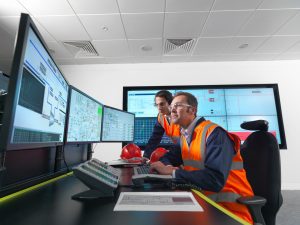The climate crisis is also an economic crisis, as climate change and its extreme weather events directly impact 70% of all economic sectors worldwide. Schneider Electric recognizes what’s at stake, not just for our own business but also for our sustainability partners.
The time to act is now. This is not a problem we can leave for future generations to solve. We must take a direct hand to drive the necessary change.
In this blog series, we’ll be detailing specifics that focus on key areas where we can make a positive impact to improve our products’ sustainability. We’re also reaching out to our partners – the engineers, designers, panel builders, and contractors who specify our products – to help them decarbonize their own operations and those of their customers. And we’ve recently launched a new award program to celebrate our partners’ successes and highlight ways others can enhance their sustainability journey.

Sustainability at a corporate level
At Schneider Electric, sustainability is at the core of our purpose, culture, business, and operating model. We view sustainability as a responsibility and an opportunity – for us, our employees, and our ecosystem of suppliers, customers, and local stakeholders.
To this end, we’ve made six long-term commitments to:
- Act for a climate-positive world
- Be efficient with resources
- Live up to our principles of trust
- Create equal opportunities
- Harness the power of all generations
- Empower local communities
We’ve also defined a path toward our net-zero target:
- 2025 – Carbon neutrality in our operations (with CO2 offsets)
- 2030 – Net-zero CO2 in our operations (no CO2 offsets)
- 2040 – End-to-end carbon-neutral value chain (carbon-neutral products, with CO2 offsets, scope 1, 2, 3)
- 2050 – Net-zero CO2 supply chain (no CO2 offset)
Transparency, consistency, and sustainability in our product division
Driven by innovation and technology, our Power Products division has established four areas of focus to help support Schneider Electric’s ambitious – and necessary – goals, including:
1. Measuring our carbon footprint across scopes.
While we are taking steps forward to reduce our CO2 footprint, keeping and accelerating that momentum is critical. Our Scope 1 & 2 emissions (operations), Scope 3 upstream (our suppliers), and our downstream emissions are all equally important.
Downstream emissions impact from the day the product leaves our factory to its end of life after 20 – 30 years and everything in between (e.g., its implementation by channel partners and along the product lifecycle at the end-user’s premises). Many companies may only focus their sustainability efforts on their supply chain emissions, energy mix, and spending. We strive to go above and beyond to care for the entire ecosystem to focus on Scope 3 downstream and Scope 4 emissions.
2. Requiring all project investment proposals to include a carbon impact assessment.
This assessment will be a key criterion for acceptance. When developing an offer beyond ROI and other criteria, we ensure that the offer brings a benefit in terms of CO2 footprint, e.g., having a lower footprint than the one it will substitute or enabling CO2 emission avoidance and savings. Further, we prioritize marketing activities to make sure that the selection of such products is favored.
3. Enabling the New Energy Landscape as a driver for Scope 3 emissions reduction.
The New Energy Landscape includes the activities we are developing to ensure that managing energy with a sustainability purpose is not contradictory with managing it with other purposes such as safety, availability, and power continuity. A more connected approach for both purposes would be great, but it is only a small piece of the energy landscape.
I view the greatest opportunity for CO2 emission reduction is more with Scope 3 (e.g, finding ways to make solutions more efficiently), but staying aware of Scope 4 opportunities and keeping in mind that the New Energy Landscape does not resume the structure of doing business in renewable energy segments.
4. Driving sustainability downstream through our Partnerships of the Future.
Our Partnering for Sustainability program takes a holistic outlook on the entire business ecosystem striving to reduce emissions and CO2 footprint from a product’s first day to its last.
Partnering for Sustainability
We know we need to align with our partners, suppliers, and customers to advance a shared vision for decarbonization, and that’s why strategic partnerships and collaborations are at the heart of our business. Since 2018, our solutions have helped customers reduce or avoid 347M tons of CO2. Today, more than 1,000 top suppliers have joined our zero-carbon project to dramatically reduce their CO2 emissions.
In July 2022 we launched the inaugural Schneider Electric Sustainability Impact awards to recognize the positive impacts achieved by partners, end customers, and suppliers who embrace our sustainability-focused technologies, philosophies, and ambitions. These awards will acknowledge the outstanding successes and innovations that sustainability partners deliver to the market in more than 100 countries in two categories:
- Partners who lead the charge themselves and decarbonize their operations.
- Partners who advocate sustainable solutions that support net-zero goals for their customers.
Visit our Sustainability Impact Award portal to learn more about this effort and how you can turn your decarbonization practices into prestige and become a sustainability partner.
To learn more about this topic, listen to the recently recorded podcast featuring guest hosts Stuart Wilson and Louisa Barker from IDC. You can find our podcast “Partnering for Sustainability” on iTunes or Spotify.



